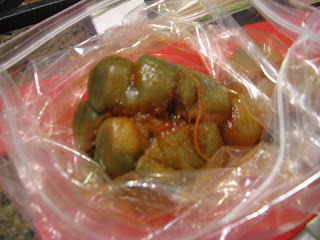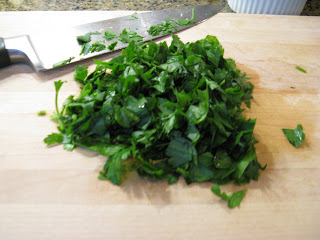.jpg)
When I was in school for the second time, I took a class called "Food Selection and Preparation" (which was a great class, btw), and I remember vividly the instructor, Dr Frank Conforti, saying "the fat is where the flavor is".
I have to say, truer words have never been spoken. When I think of my favorite foods, they are all high in fat (or at least have fat as an essential component). Potatoes au gratin? fat (cream and cheese). Steak? rib-eye, well marbled and with nice fat on the edges and in the middle. Pasta? Cream sauce, or something like a tuna sauce (packed in oil, of course). Gravy? Fat in the roux. The list is endless.
The larger point is, of course, that fat really is where the flavor is, and cultures where they recognize that, and practice moderation instead of deprivation, are usually much happier and healthy (ie, the "french paradox").
Well, you can add this week's recipe to the list of "high fat goodness", because there is nothing low fat about this dish. This time, I decided to take a whack at "red-braised pork". Pretty much every cuisine has a couple "low and slow" dishes, and sichuan cuisine is no different.
Red-braised pork is basically pork belly, cut into chunks, and then braised for a couple of hours in a sweet/salty sauce until the meat is really tender and the fat has a really cool texture.
This dish is definitely a different kind of dish. For one thing, most people are used to eating pork belly in the form of bacon, and when you cut up the belly into chunks like stew meat, you get these really cool bands of meat and fat. When you cook them for a while, the meat gets really tender, but the fat doesn't melt away, but rather it gets a unique texture. Tasty, but different. Along with the fat, pork belly comes with the skin attached, and you don't remove the skin when you cook it. I had serious doubts about this part, thinking that the belly chunks would have this rubbery strip along the top, but I was way off base. The skin has a lot of collagen in it, and over the course of several hours, it all gets rendered out into the sauce. To be honest, you don't even realize it's skin. (I know my youngest daughter loved this dish, and ate all that I gave her, skin, meat and fat, and she is ridiculously picky, as only a 5yr old can be).
I served the pork with some rice, and also some roasted green beans. I was inspired to roast the beans because I was at a party a couple of weeks ago, and somehow I got involved in a conversation about roasting green beans, and I figured since I needed something to serve with the pork, I'd have a go at roasting beans, and then I'd have something else to write about.
Roasting green beans is pretty much like roasting asparagus, I think. You clean your beans, trimming them if necessary, then you dry them, toss them with some olive oil, kosher salt and fresh ground pepper, and then spread them out on a sheet pan. Roast them in a 450deg oven for about 10-12 minutes, and you're done. The only thing I'd change about the way they turned out was that I used pretty thin beans (haricot vert thin), and I think this would work better with thick beans.
So there you go, some fat pork, some roasted beans, and some nice rice, and a sauce that's pretty darn good. What's not to like?
.jpg)
Red Braised Pork:
1 - 1 1/4 lb pork belly, with skin
2 in. piece of ginger, unpeeled.
2 scallions, white and green parts
1 tbsp peanut oil
2 cups chicken stock
1 tbsp dark soy sauce
2 tbsp shaoxing rice wine
3/4 tsp salt
3 tbsp brown sugar
1/2 of a star anise
Blanch pork for a few minutes in boiling water, and then rinse in cold water. Cut into 2 -3 in. chunks, leaving skin on. Crush ginger with flat side of a cleaver or chef's knife, and cut scallions into 3 to 4 sections.
Heat oil in a dutch oven, and brown pork chunks on all sides. Work in batches if necessary. After all the pork is browned, add it all to the pot, and add stock and the rest of the ingredients. Bring to a boil, and then simmer uncovered for 2-3 hours over a low flame.
When meat is fork tender, if the braising liquid is not reduced enough (it should coat a spoon), remove the pork to a serving dish, and reduce the braising liquid over high heat until it coats a spoon. Pour braising liquid over the pork and serve immediately with rice.
.jpg)
Roasted Green Beans:
1/2 -1 lb green beans (thick)
2-3 tbsp olive oil
coarse kosher salt
fresh ground pepper
Clean and trim beans as necessary, and dry. Toss in a bowl with olive oil, salt and pepper, and then spread beans on a sheet pan. Roast in a 450deg oven for 10-12 minutes, or until nicely browned.
Serve hot.










































.jpg)









